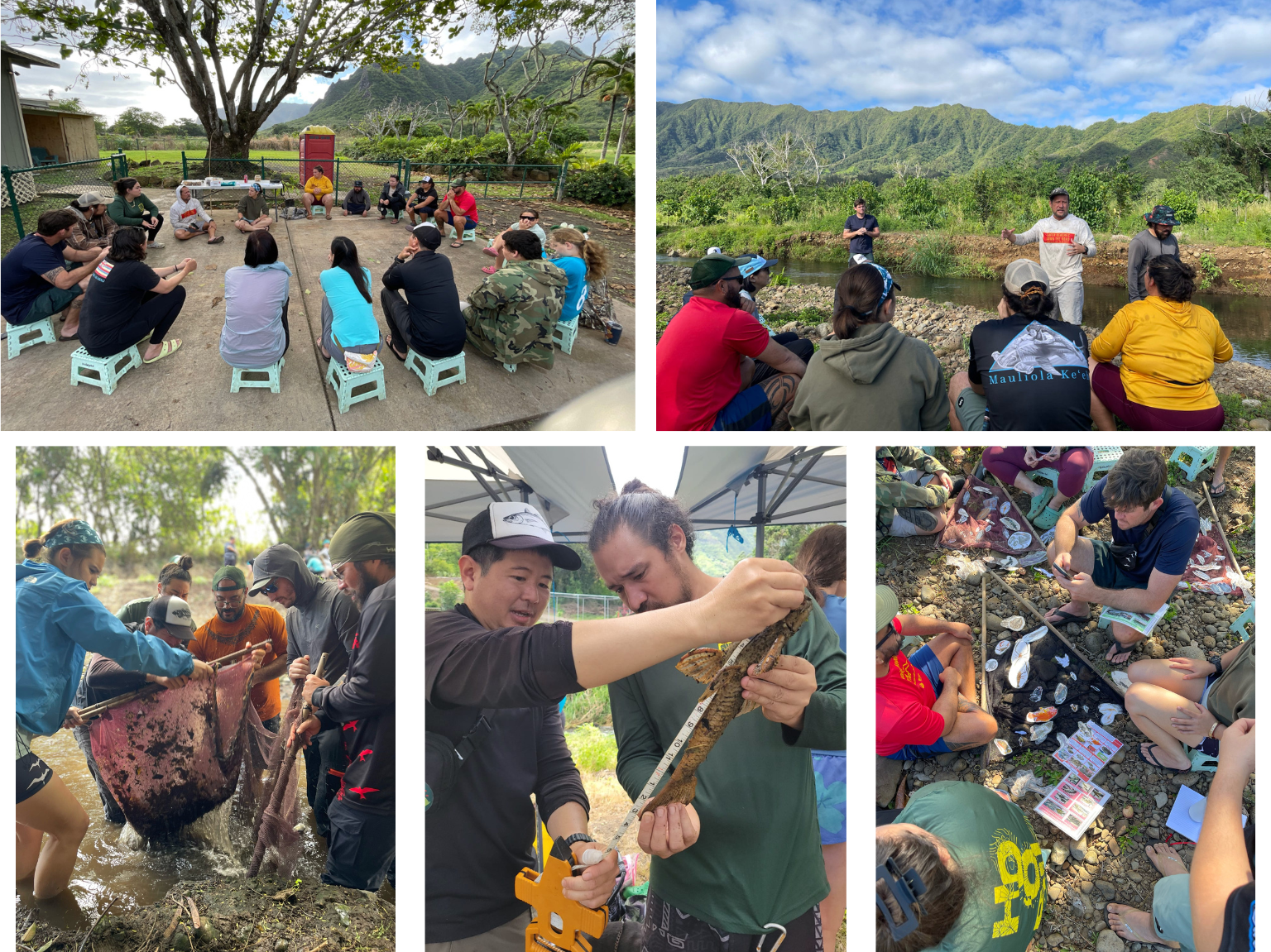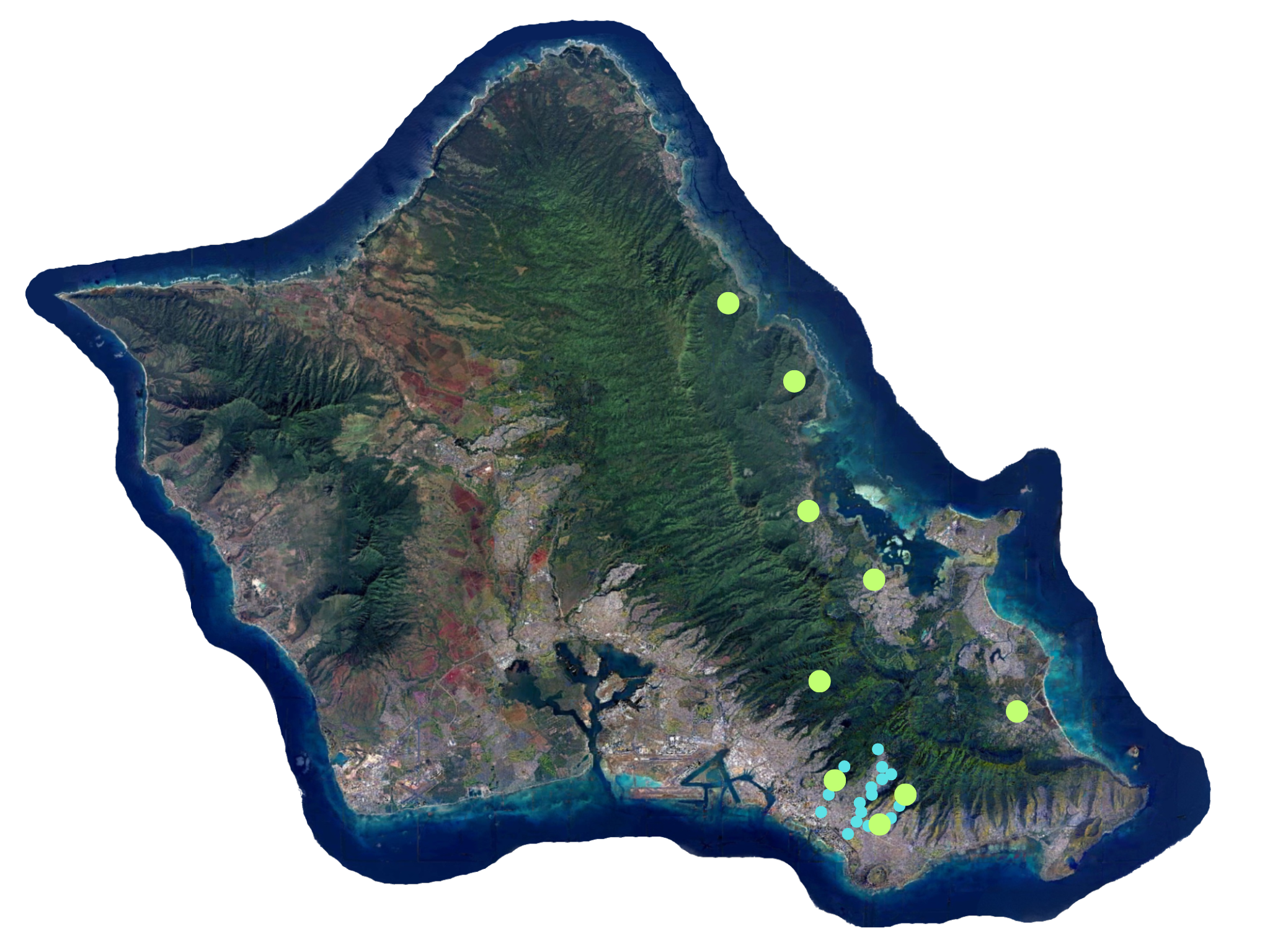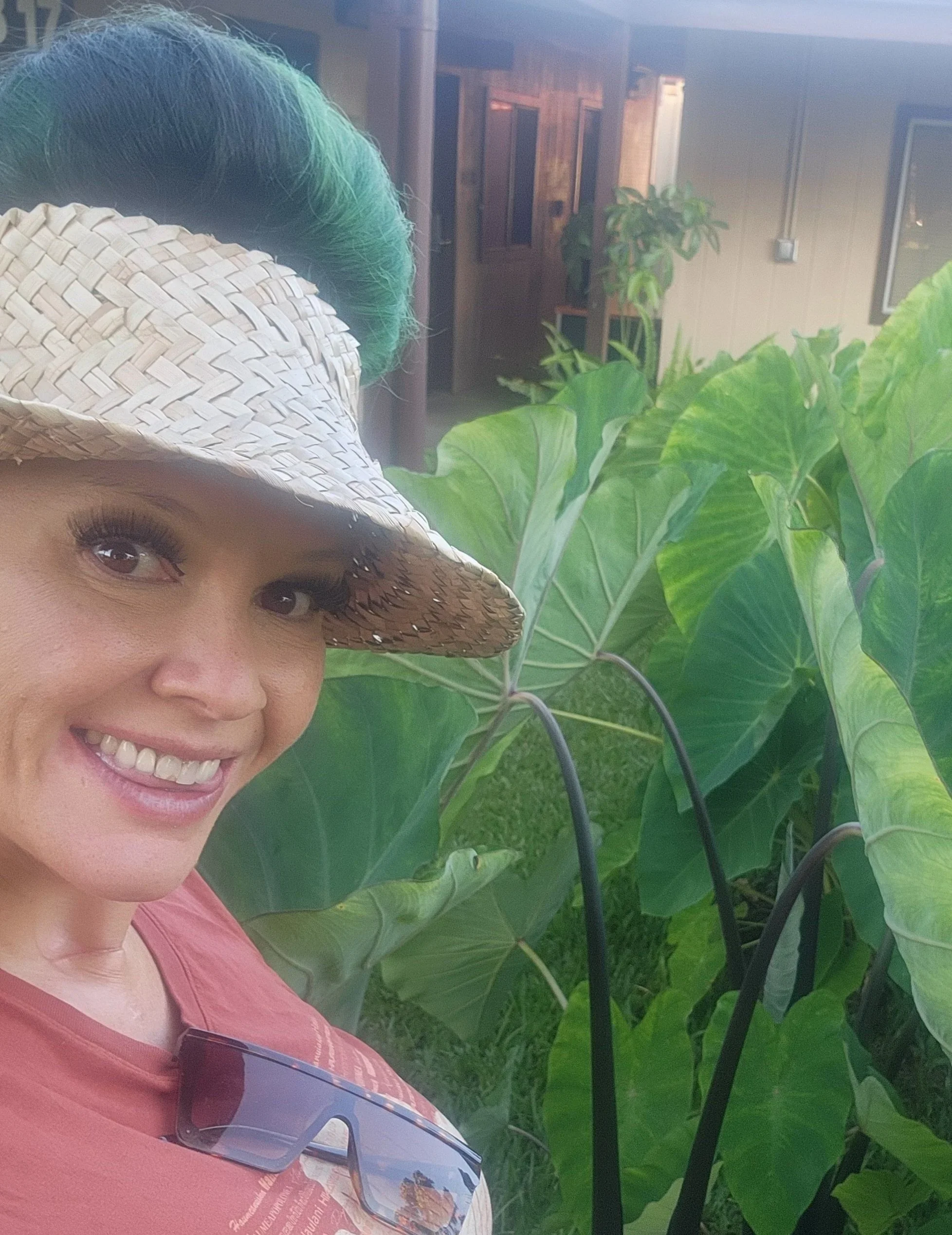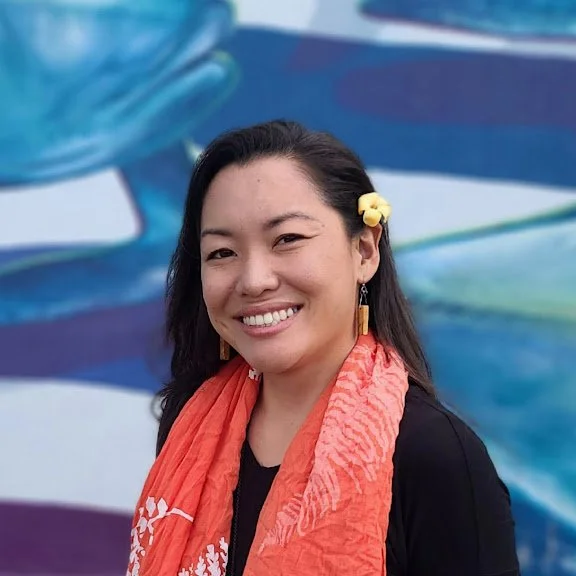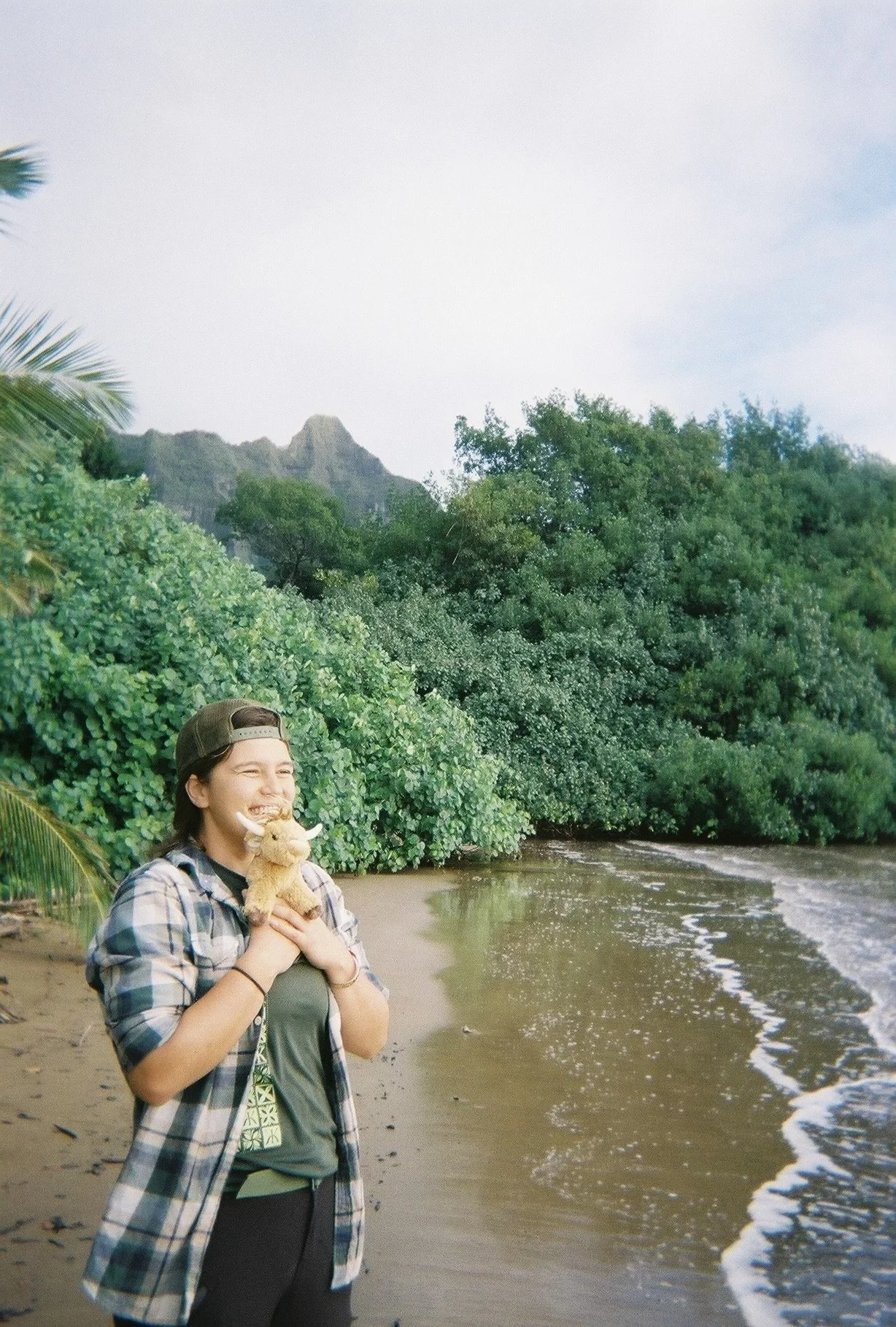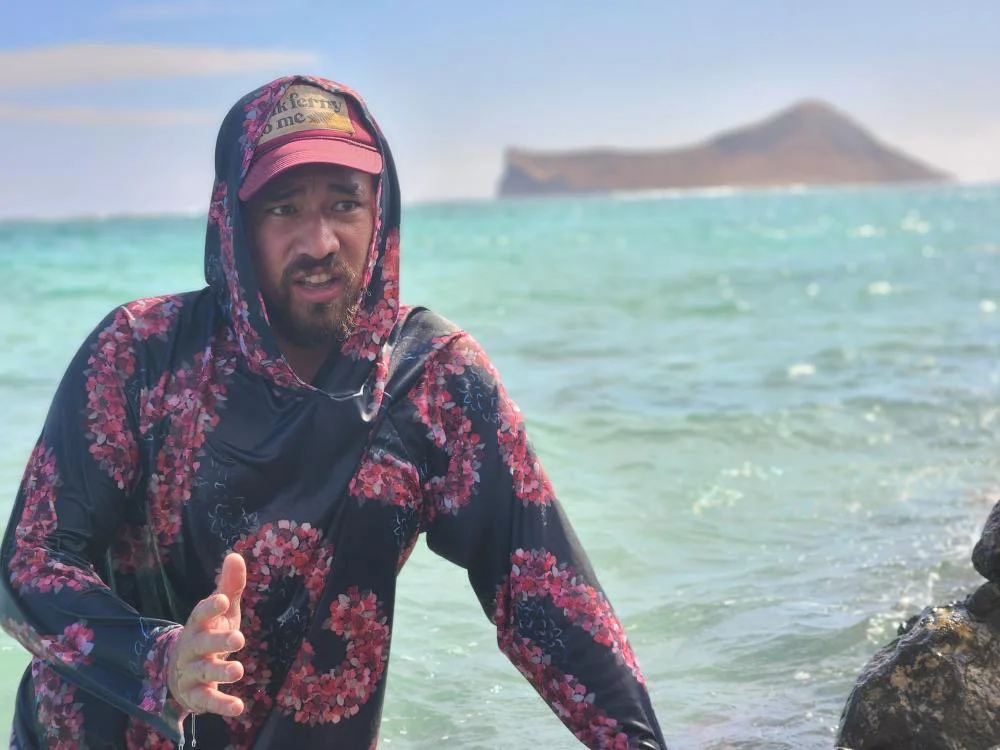Hoʻokahe Wai Fellows
A community of practice for stream educators
Through our core program, we work with nearly 3,000 students per year monitoring 20 sites in our home waters of Pālolo, Mānoa, and Makiki. Each year due to our own calendar capacity and limited bus availability and funds for field trips, there remains many barriers to engaging more students in in connection with these and other streams. To preserve a narrow focus and responsibility for the waters we most immediately belong to, we knew it was time for us to think and grow in ways that would improve equitable access to stream monitoring experiences for students across Oʻahu. In talking with dedicated kiaʻi and friends who are already deeply engaged in community-driven stewardship and restoration practices in and around their streams, we came to realize there is a common desire to better understand ʻoʻopu as messengers or indicators of stream health. The group started to form organically and in recognizing a need to fund the endeavor, our Paʻēpaʻē crew decided to apply for a NOAA BWET grant under the following question, “In what ways can collaborating to develop Meaningful Watershed Educational Experiences (MWEEs) not only enhance our capacity to collect scientific data for watershed monitoring and restoration but also strengthen the social bonds within a community of practice?”
Read on to learn more about the members and exciting work of this group!
Stream areas under stewardship by our fellows and their communities
Blue dots show Paʻēpaʻē o Waikolu original core program survey sites in Pālolo, Mānoa, and Makiki
Green dots show new stream sites held by fellows or original sites that will now be surveyed by a fellow and their learning community.
Meet the Fellows!
Aside from their desire to learn new methods for surveying fish populations from Coryʻs decade plus of experience, each of our fellows brings their own brilliance, skills, and rich traditions to offer our community of practice. From fish pond management and commercial farming, to uhau humu pōhaku (dry stack rock weaving), native plant restoration, land history research, and ʻōlelo Hawaiʻi terminology that best describes stream work… With these strengths as a foundation for collective learning, we are all supported in seeking a greater understanding of our shared sense of place and collective responsibility to grow as educators so we may in turn grow more students rooted in learning on and from the land.
Kanaloa Bishop - Punaluʻu Stream
Who are you representing on this journey? The community of Ko'olaupoko and Ko'olauloa… Stream lovers and protectors of wai, reef people, farmers.
Biggest challenge facing the stream and/or area you steward… Invasive species and erosion
Future vision of health for your stream and place… A stream packed with natives so that it is a food source, loʻi kalo and other food crops abundant, a fishpond at the mouth with ʻamaʻama and awa, a living reef heʻe and pākuʻikuʻi, people thriving.
Favorite quote, ʻōlelo no'eau, saying …. ua lawa mākou i ka pōhaku, ka ʻai kamahaʻo o ka ʻāina. — We are satisfied with the stones, the wondrous food of the land
What are you most looking forward to by participating in this Fellows Program? Making a positive impact on stream ecology and educating youth/community
———
Kanaloa and his other half run an education non-profit called, “Waihapakai”. Click here to check out their mission and work.
Jon Watase -
Pālolo Stream
Who are you representing on this journey? Saint Louis School and the community of Pālolo Valley. I’m a proud graduate of Saint Louis, and my ties to Pālolo run deep. Taking care and being a steward for this place means a lot!
Biggest challenge facing the stream and/or area you steward… The biggest challenge is the impact of people-whether through neglect, misuse, or lack of awareness.
Future vision of health for your stream and place… A vibrant learning space where community members come to restore the stream, grow food in a thriving food forest, and feed one another. A space of nourishment, education, and healing.
Favorite quote, ʻōlelo no'eau, saying …. he 'onipa'a ka 'oiā'i'o — Truth is not changeable.
What are you most looking forward to by participating in this Fellows Program? Working with great people!
———-
Aside from his role as ʻĀina-Based Education Director at St. Louis School, Jon is also a Mamaki farmer! Click here to read more about his work
Ramsey Fiorello - Mānoa Stream
Who are you representing on this journey? Hālau Kū Māna 'ohana and haumāna.
Biggest challenge facing the stream and/or area you steward… A lack of supplies makes it difficult to carry out the restoration and stewardship that is needed.
Future vision of health for your stream and place… ʻĀina restoration and the return of native species. Bringing life and balance back to Makīkī and Mānoa streams.
What are you most looking forward to by participating in this Fellows Program? Working with different communities to help restore the health of our streams.
Aimee Sato -
Heʻeia Stream
Who are you representing on this journey? I represent Kahaluʻu as my current home and the hui that stewards the Kahaluʻu Loʻi in the back of ʻĀhuimanu. I also represent the neighboring ahupuaʻa of Heʻeia where I have the honor of working in as the Stewardship Coordinator. I am proud to be a part of a collaborative effort to better care for the people and place of Heʻeia.
Biggest challenge facing the stream and/or area you steward… The biggest challenge facing the stream that I am trying to address is invasive stream species.
Future vision of health for your stream and place… My dream is to see an abundance of native species (ʻoʻopu, hīhīwai, ʻōpae) replacing the invasive species, to the point where the community will be able to harvest sustainably for food! ʻĀina momona!
Favorite quote, ʻōlelo no'eau, saying …. “HULI KA LIMA I LALO, OLA KE KANAKA” When your hands are turned down in the ʻāina, there is life.
What are you most looking forward to by participating in this Fellows Program? Strengthened and new friendships with likeminded individuals.
———
Kimeona Kane - Puha Stream
Who are you representing on this journey? During this particular journey, I am inspired by and honoring my birthplace of Waimānalo, Koʻolaupoko, Oʻahu. Being the home I have known my entire life, it is where I hope to elevate and continue to preserve.
Biggest challenge facing the stream and/or area you steward… Navigating access and creating pathways of stewardship through various agencies. A key challenge is holding these agencies accountable and pushing for higher standards—particularly for in-stream testing by the Department of Health's Clean Water Branch.
Future vision of health for your stream and place… Healthy and intentional access to the full water system—from the poʻowai of Kupuna Kane flowing from Aniani Nui, to the punawai known as Kupuna Wahine in view of Ka Lua o Pele. A future where all wai systems of Waimānalo—Muliwaiʻōlena, Inoaʻole, and Waiokeola—are respected, cared for, and restored.
Favorite quote, ʻōlelo no'eau, saying …. Hoʻokāhi no lā o ka malihini. — A stranger only for a day.
What are you most looking forward to by participating in this Fellows Program? Strengthening my understanding of the freshwater/stream ecosystem to better advocate for wai and related opportunities.
Mele Ana Kastner - Hakipuʻu & Kaʻaʻawa Stream
Who are you representing on this journey? Kualoa Ranch and especially Kaʻaʻawa Krew.
Biggest challenge facing the stream and/or area you steward… Connectivity and invasive species.
Future vision of health for your stream and place… For Kaʻaʻawa Stream to be completely connected year-round to the sea and to see ʻōopu, hapawai, hihiwai, and ʻopae flourishing in the valley.
Favorite quote, ʻōlelo no'eau, saying …. He ʻaʻaliʻi ku makani mai au! ʻAʻohe ka makani nāna e kulaʻi. — I am wind resistant ʻaʻaliʻi; no gale can blow me over.
What are you most looking forward to by participating in this Fellows Program? To learn about hydrology and how to effectively restore riparian spaces.
———-
Mele Ana and her stewardship crew are responsible for planning and implementing restoration efforts for 4,000 acres of Kualoa Ranch. Click here to see more about their mission.
Aolani Higgins - Kalihi Stream
Who are you representing on this journey? Kalihilihi-o-Laumiha; Hoʻoulu ʻĀina is proud to be part of the Kalihi community because we reflect the strength, resilience, and aloha of the people who call this place home.
Biggest challenge facing the stream and/or area you steward… The stream is hard to access due to steep, slippery hillsides. Nearby ponds are accessed by many without knowledge or respect, leading to litter, erosion, and invasive species like bass and Samoan crab. Downstream, the area becomes very urban and industrial, causing increased trash and pollution.
Future vision of health for your stream and place… A thriving Kalihi where land, waters, and people are in balance; streams run clear and full, nourishing food forests with native species outnumbering invasives. A community deeply connected to ʻāina and each other, rooted in care and reciprocity, where traditional food systems thrive and generations steward the place with aloha.
Favorite quote, ʻōlelo no'eau, saying …. ʻO ka hā o ka ʻāina ke ola o ka poʻe — The breath of the land is the life of the people.
Heleleʻi ka pua ʻōhiʻa, A ʻula ka ʻoʻopu, Ola i ka wai — When the pua ʻōhiʻa rains, red are the ʻoʻopu; water thrives!
What are you most looking forward to by participating in this Fellows Program? Getting tools to safely lead keiki in stream work, learning native cycles to restore habitats and food sources, being part of a supportive collective, and learning techniques to work safely, correctly, and pono.
———-
Joe Wat -
Waiheʻe Stream
Who are you representing on this journey? In this hui, I am representing KEY Project, a community center in Waiheʻe, Koʻolaupoko, Oʻahu. Founded in 1968 as a deeply collaborative community effort, I am extremely proud to contribute to this organization with deep ties and accountability.
Biggest challenge facing the stream and/or area you steward… Kahaluʻu has the highest concentration of leech fields in Hawaiʻi. This makes the outlet where Waiheʻe, Kahaluʻu, and Ahuimanu streams one of the most bacterially dense waterways in Hawaiʻi. (Click here to view Surfriderʻs monitoring)
Favorite quote, ʻōlelo no'eau, saying …. ʻAʻohe Hua I Ka Maiʻa I Ka Lā Hoʻokahi - a banana does not fruit on the first day. Good things take time, be patient and grow at the speed that you can grow!
——————————
Joe and his crew at Key Project are responsible for organizing and facilitating incredible community strengthening programming that serves everyone from keiki to kūpuna. Check out their work here
Kēhau Llanos - Pūkele Stream
As a kumu at Kula Kaiapuni o Ānuenue, Kēhau has connected students in her Papa ʻEhā and ʻElima to work and learning along Pūkele Stream for over a decade. Her dedication to educational excellence through ʻōlelo Hawaiʻi immersion and place-based learning has been a gift to this Pālolo Valley learning community and beyond.
More info to come!
nānā i ke kumu… Look to the source
The name of this cohort is an excerpt from the phrase, “Hoʻokahe wai, hoʻoulu ʻāina”- when the water flows, the land thrives or more actively stated… LET the water flow, LET the land thrive – practical and metaphoric guidance spoken by the influential kalo farmer and healer, kupuna Harry Kunihi Mitchell to a small group of University of Hawaiʻi students in the 1980s who sought his expertise in their reclamation and restoration of a former terraced loʻi that had tragically become a neighborhood dumping site. The resulting Ka Papa Loʻi o Kānewai has now been stewarded by generations of students, teachers, and community members as a kīpuka— a gathering place, a cultural learning space, an ancestral food hub, and a beacon of possibility for the next generation of young students who seek to heal problems they witness in their watershed. We hope bringing forth Uncle Harry’s words will remind us to look back and follow the lead of stewards and kumu who came before us, in order to ready ourselves to nurture the passions of eager students who may call upon us for guidance.
We can look to the systems and structures of the natural world for evidence of how Uncle Harryʻs words ring true and connect us all— humans, kalo, ʻoʻopu, and the land itself. Each benefits from the open flow of water. Just as our bodies are made healthy by the flow of oxygenated blood through open vessels, streams must remain open and free of barriers or blockages to allow kalo to receive nourishment and ʻoʻopu to maintain passage between the mountain and the ocean. And if we look at water as wisdom, our students deserve to thrive in a steady uninterrupted flow of learning. We ultimately hope the act of taking out invasive species in these surveys removes a biological barrier to ʻoʻopu passage, in the same way we hope the fellows program removes barriers to stream relationships and learning for our students and communities.

